rural consequences of industrialization
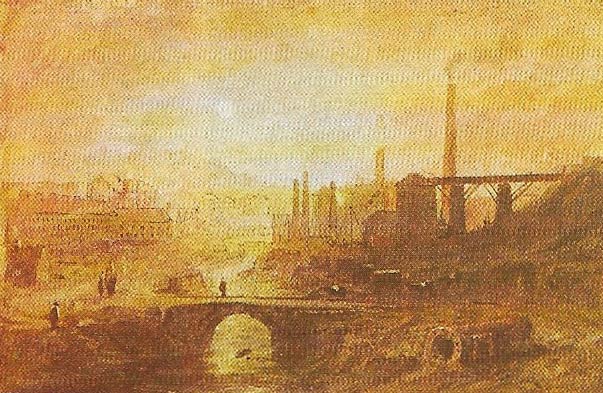
Figure 1. The Nant-y-Glo ironworks in Wales in an early 19th-century picture presents a prospect soon to become too familiar – industrial pollution. While it was occasional and localized, pollution could be ignored or sometimes enjoyed as a "sublime" vision of hellishness. Despite the unhealthiness and squalor of the conditions in which they worked and were housed, to many in the most poverty-stricken areas industry brought a welcome opportunity to earn a living. Ironworks in South Wales and coalfields in the valleys attracted labour from the surrounding regions and some men came on foot from North Wales. Factory life was even thought preferable to farming.
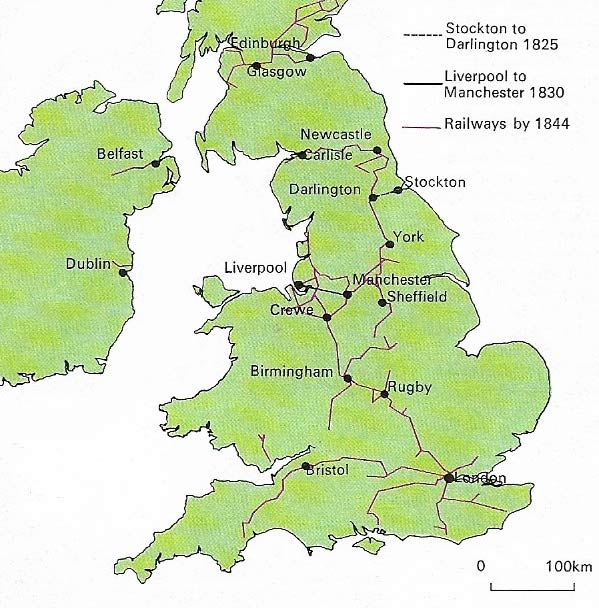
Figure 2. The map shows the routes of the earliest railways in Britain, initiated by the opening in 1825 of the famous Stockton-Darlington railway. The railways were in fact only the third wave of improvements in transport in Britain since the 17th century. The building of turnpike roads and canals had a Ready done much to transform communications and trade, and made travel itself more convenient and enjoyable – the 18th century was a golden age of British tourism. The success of the Stockton-Darlington railway – it more than halved the cost of coal on Stockton – initiated a railway boom, that bound the once distant provinces into an interdependent trading grid, establishing industries for from cities and ports.
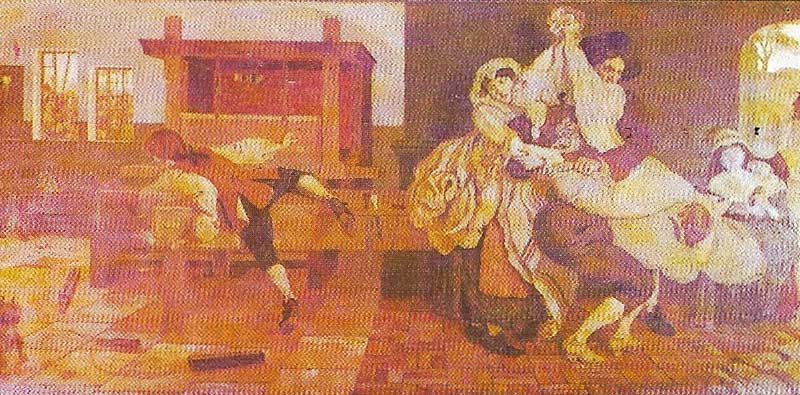
Figure 3. John Kay, inventor of the flying shuttle in 1733, is wrapped in a sheet so as to make good his escape from the wrath of rioters at his window. The flying shuttle put out of a job those who previously had thrown the hand shuttles, and enabled a loom to be worked by one weaver alone. By undermining the rural cottage industries, this and other inventions concentrated within the town the main sources of employment. These rioters were members of an urban workforce whose divorce from the land would soon be politically significant.
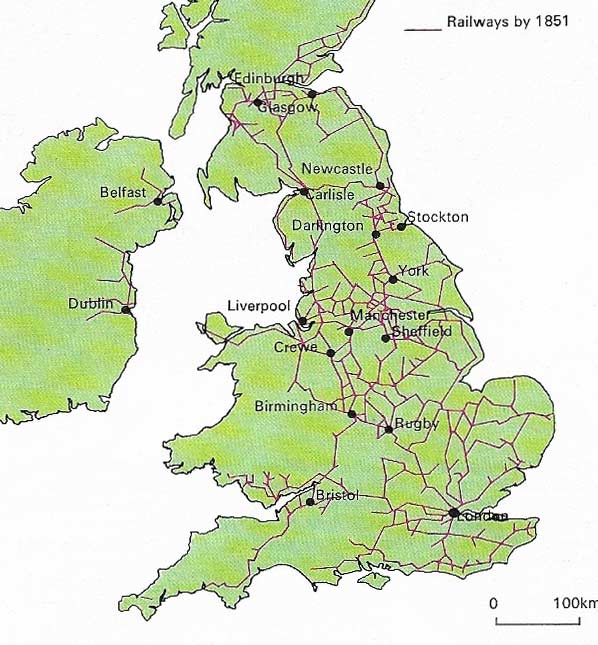
Figure 4. An expanding network was established by 1851. The bridges, tunnels and stations created by the railway engineers proved that the transformed landscape was nowhere inaccessible. But although the influx of trade brought whole new towns, such as Swindon, into being in the Midlands, the more backward parts – much of Wales, Scotland and Ireland – were unaffected. The new habits of leisure travel induced by railways could be seen in the success of the tours organized by Thomas Cook (1808–1892).
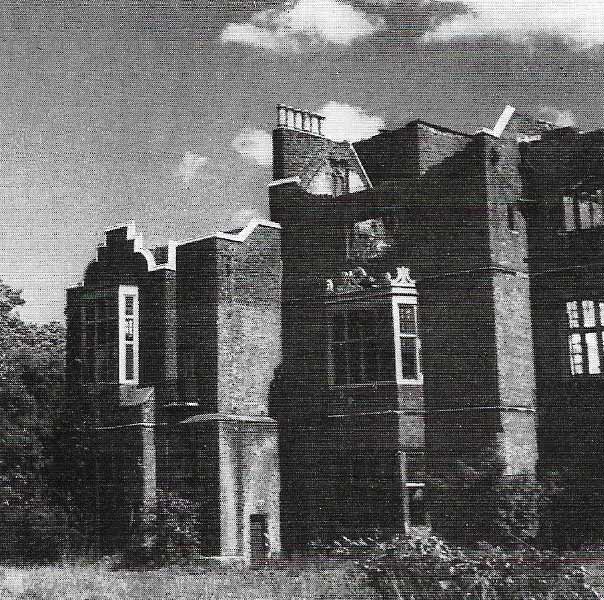
Figure 5. The destruction of the country house is a recent consequence of industrialization. In previous centuries the country house was the center from which all agricultural wealth was created, and the unit of local power. Its architecture was an expression of its owner's local status and national role, even if his money came originally from trade or the colonies. After industrialization the country house lost its economic and political vitality and importance.
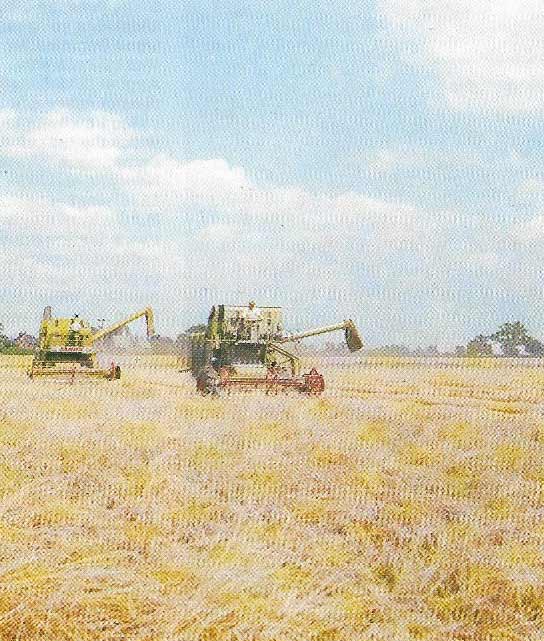
Figure 6. Industrialization of the farm itself is one of the inevitable consequences of the mechanization of the entire economy. The trend towards investment in machinery to do the work of many men had made machines such a combine harvesters a commonplace on the land. To obtain sufficient returns on capital outlay farms have had to expand greatly.
The Industrial Revolution had profound consequences for agriculture and rural life. Population growth and increasing urbanization stimulated a demand for foodstuffs of every kind, which in turn made necessary a drastic expansion and development of agriculture. This involved the reclamation of marginal waste land, the reorganization of landholding through enclosure, the introduction of new crops and techniques, the scientific breeding of healthier and bigger animals, and a more efficient, capitalistic type of farming, the result was a sufficient increase in domestic agriculture production to satisfy the demands of an expanding population until the last quarter of the nineteenth century, when cheap foreign foodstuffs became generally available.
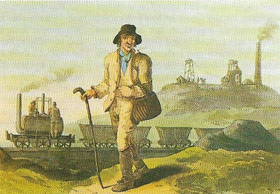 |
| A Yorkshire miner of 1814 retains a rural look against an early industrial background. Behind him the steam driven pit head winding-gear brings coal and miners to the surface, and a Blenkinsop locomotive hauls tubs of coal as hills stretch behind. During those early days of industrialization, mining and textile communities were hardly different from farming villages, slightly larger but not yet obtrusive. With the expansion of industry accompanied by a rise in population, factories and housing began to encroach on the rural landscape so much that the countryside in many places became a mere interval between towns. Urban "sprawl" has continued to this day. |
Unemployment on the land
The expansion of agriculture was not sufficient to absorb all population growth on the land. Although the number rose from 697,000 in 1811 to 761,000 in 1830, many were forced by sheer economic circumstances to swell the workforce of the industrial towns.
Those who remained were often faced with poor prospects. In the rural south, the system of subsidizing wages from parish rates, introduced by the magistrates of Speenhamland in Berkshire in 1795, discouraged farmers from paying economic wages. Moreover, population growth created conditions of chronic rural unemployment, which depressed farm wages level to near subsistence level. The harsher New Poor Law of 1834 gave farm laborers the choice of low wages or even worse conditions in the workhouse. By the end of the century, the rural counties still had the highest levels of poverty in the country, often as bad as the worst urban slum areas. Cottage industry too, especially handloom weaving. Was badly hit by competition from the factories. Although enclosure did not immediately reduce the agricultural labour force, often actually increasing the demand for labor, wages on the land remained persistently lower than those in industry.
By the turn of the century a drift from the land was accelerated by the depression in prices for farm produce. By 1901, less than 10 percent of the total labor force in the country was involved in agriculture.
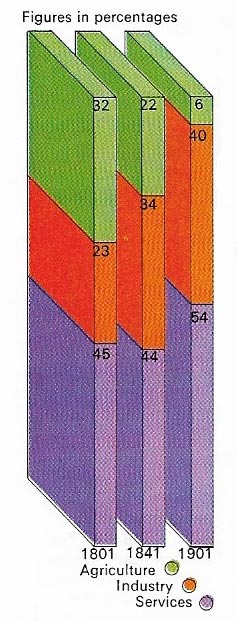 |
| The proportion of workers employed in industry and services and in agriculture altered greatly between 1801 and 1901. This comparison reveals a clear drift away from the land into cities; a trend that continues. |
"High farming" period
Mechanization had not played an important part in the agricultural improvements of the eighteenth and early nineteenth centuries. Seed drills and threshing machines had some success, but the latter aroused opposition in the "Captain Swing" disturbances of 1830–1832. The mid-Victorian "high farming" period saw the introduction of more elaborate machinery, including the use of traction engines for steam ploughing. These machines were expensive and not suited to every type of soil, but many new types of apparatus were in use by 1870.
The introduction of the internal combustion engine in the 20th century had a dramatic impact on farming. Tractors proved useful for a wide range of tasks and, by 1939, there were 55,000 in use. By 1945, there were more than 200,000 tractors working in Britain and more than 50,000 combine harvesters (Figure 6). Electricity was also being used for milking and heating. Technology was applied to a wide range of farming techniques. Animal husbandry was now more scientific and embraced battery farming and complex fertilizers and feedstuffs. The dwindling workforce became much more highly skilled as manual labour was taken over by machinery.
Rural enfranchisement
Social relations on the land were much influenced by the changes in agriculture. Very gradually since the 16th century the rural "middle class" of tenant-farmers and yeomen was displaced by the larger landowners and farmers, who employed landless wage-laborers. The dominance of squire and parson was undermined by the reorganization of local government. In 1884, most agricultural labourers received the vote. The Ballot Act of 1872 also removed the, from more obvious forms of landlord domination by introducing the secret ballot. The establishment of county councils in 1888, and parish councils in 1894, aided the decline in the influence of the landlord. The early successes of Joseph Arch's Agricultural Trade Union in the 1870s illustrated the permeation of union organization among the agricultural labourers; its progress was nevertheless much slower than among industrial workers.
Many rural areas were brought into the Industrial Age only with the coming of the railways in the late Victorian and Edwardian eras (Figures 2 and 4). The last phase of the railway expansion brought branch lines to many hitherto untouched areas. This trend was reversed following the Beeching Report in 1963 which recommended cuts of 8,000 kilometers (5,000 miles) of railway. Subsequently, reduction in public transport further isolated many towns and villages. As a result, the motor car became a necessity for those living and working out of town.
The car also enabled city-dwellers to enjoy rural pleasures more easily. Large areas of land were set aside as national parks, to be preserved from urban encroachment, while other parts of the countryside were developed for tourists.
